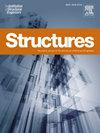Structural performance of ultra high-performance precast segmental hemispherical domes under monotonic concentrated load
IF 3.9
2区 工程技术
Q1 ENGINEERING, CIVIL
引用次数: 0
Abstract
Reinforced concrete (RC) domes are structural membrane elements commonly used as roofs for architectural and industrial purposes. However, constructing RC domes poses significant challenges due to the complexity and cost of formwork, which is time-consuming and expensive. Additionally, traditional concrete contributes to high self-weight, which significantly affects the dome's load-carrying capacity. Recently, a new type of concrete, ultra-high-performance concrete (UHPC), has become commercially available after years of development. UHPC offers superior mechanical properties and durability compared to traditional concrete. This study proposes a novel construction method for domes using precast UHPC segments to reduce construction time, weight, and cost while improving durability and service life. A finite element model (FEM) was developed to numerically evaluate the performance of precast UHPC segmental hemispherical domes. Five cases were considered in this study; dividing the dome meridionally, dividing the dome into multiple rings, dividing the dome in two directions (meridionally and horizontally), strengthening the segmental dome with CFRP sheets, and valuating the effect of different base boundary conditions. The results indicated that meridional division showed good performance, with a reduction in ultimate load capacity of approximately 10 %. However, the failure mode shifted from punching shear failure (in traditional RC domes) to flexural failure. Domes constructed with multiple rings exhibited greater reductions in ultimate load capacity compared to those with meridional segments. Similarly, dividing the dome in two directions resulted in a more pronounced reduction than joints in one direction. Despite a slight reduction in ultimate load capacity, precast UHPC segmental domes remained within acceptable limits. This innovative construction method demonstrates potential for reducing the time and cost associated with RC dome construction while maintaining satisfactory structural performance.
求助全文
约1分钟内获得全文
求助全文
来源期刊

Structures
Engineering-Architecture
CiteScore
5.70
自引率
17.10%
发文量
1187
期刊介绍:
Structures aims to publish internationally-leading research across the full breadth of structural engineering. Papers for Structures are particularly welcome in which high-quality research will benefit from wide readership of academics and practitioners such that not only high citation rates but also tangible industrial-related pathways to impact are achieved.
 求助内容:
求助内容: 应助结果提醒方式:
应助结果提醒方式:


